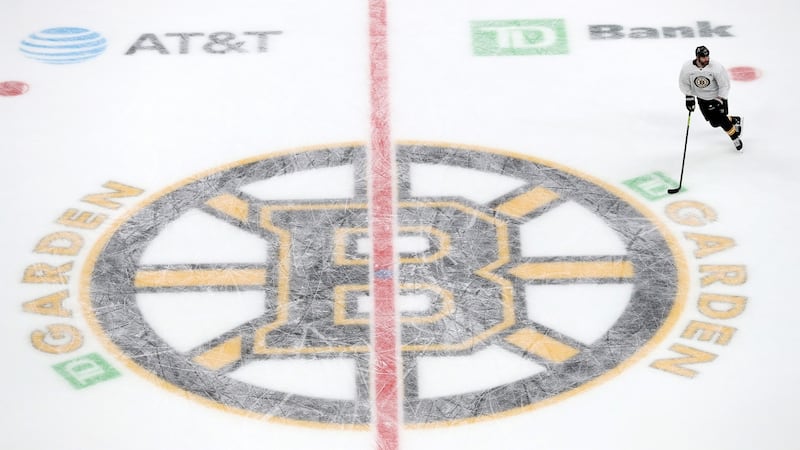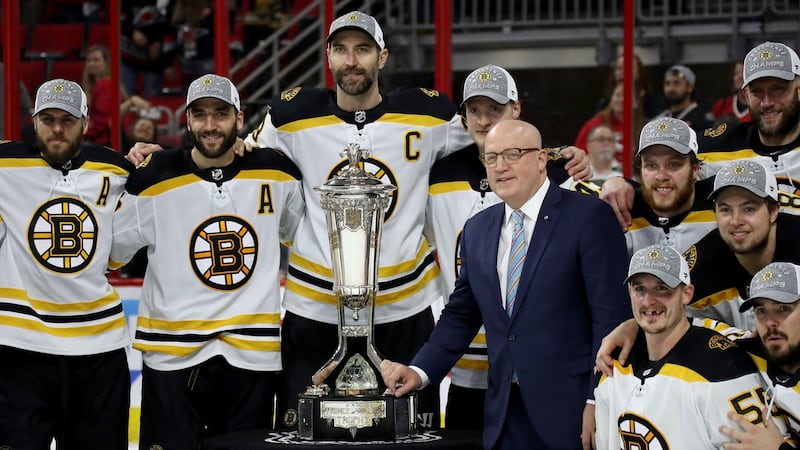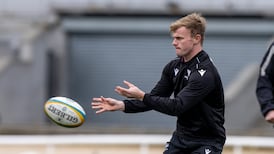Almost three months after ending up a reluctant bit part player during Conor McGregor’s bizarre self-promotional visit to the Boston Bruins’ locker room, Zdeno Chara is keeping better company. Before the start of the Stanley Cup finals against the St Louis Blues last Monday night, the club captain released a hype video of his own. Far from the foul-mouthed shamroguery of the whiskey peddler, he pieced together an eloquent collage of images showing the team’s history and acknowledging its place in the hearts of the city, replete with a script voiced by the New England Patriots’ Tom Brady.
The normally reticent quarterback’s willingness to contribute to the production offers a clue to Chara’s immense standing in Boston. In 13 seasons since arriving from Ottawa, he’s led the Bruins to the playoffs 10 times and won the club its first Stanley Cup for nearly four decades in 2011. But it’s more than that. At six foot nine, weighing in around 18 stone, the 42-year-old can often be seen (how could you miss him?) cycling around the North End neighbourhood where he lives. Eschewing the insulated velvet rope existence of the modern athlete, the Slovakian behemoth has woven himself into the fabric of the town.
In the final minutes of the Bruins’ victory over the Blues in Game One last Monday night, Chara blocked a point-blank Vladimir Tarasenko shot with his left forearm. The puck sliced the skin open and he left the ice with blood dripping from an open wound. As most Boston fans wondered immediately about the severity of the injury, others joked that the red stuff clotting on his arm finally proved that their age-defying hero was, after all, human.
“I’m fine,” said Chara afterwards. “I just got a cut so I just needed a couple of stitches.”

Against the Blues, Chara often formed a defensive line alongside Charlie McAvoy, who was born 32 days after his team-mate made his NHL debut in November, 1997. There were no indications back then that the gangling youngster starting out with the New York Islanders was destined for either greatness or longevity. Having moved across the Atlantic Ocean, he was still getting to grips with English in the locker-room. These days, Chara is fluent in six languages and proficient in a handful of others. In every aspect of his life and career, the arc always bends toward self-improvement.
At 17, his father brought him to try out for a team in his hometown of Trencin and the coach reckoned the teenager had no chance of ever making it as a professional. Zdenek Chara, a Greco-Roman wrestler who won 11 national titles in Czechoslovakia and competed in the 1976 Olympic Games, took offence at that judgement and vowed his son would prevail. But, even those who watched Chara in junior hockey never earmarked him as one to watch. They weren’t to know his extraordinary attitude would lead to him becoming the tallest ever NHL player, and, for a long time, owner of its hardest shot.
Chara’s approach to looking after his body and bettering himself is borderline OCD. He keeps detailed folders in which he chronicles every training session going back decades. Meticulously recording every time he lifts weights, how many practice shots he unleashes, and how many bleachers he runs, this is somebody who has spent off-seasons climbing Mount Kilimanjaro, cycling stages from past Tour de Frances, and grappling with Olympic wrestlers. He gave up eating meat and eggs a couple of years ago and his monastic lifestyle off the ice partly explains why the Bruins recently re-upped his contract past his 43rd birthday.

In the quest to keep playing and, more importantly, to keep contributing far beyond a player’s usual sell-by date, Chara often looks outside his own sport. Aside from studying icons as different as Lionel Messi and Brady, he has enlisted the help of Olympic weightlifters to improve his strength, and worked with speed skaters and ice dancers on his footwork and form. Intimidating as he may look (Wayne Gretzky said the emergence of super-sized defenders like Chara encouraged him to retire), he moves with a grace not normal in somebody with his hulking frame.
If the physical prowess is what led Sports Illustrated to dub him “The Legend of Z”, there is much more to Chara than the menacing presence who nearly killed Montreal’s Max Pacioretty with what officials dismissed as merely “a hockey play”. When the NHL launched an anti-homophobia campaign some years back, he was front and centre in the launch video, the presence of one of the league’s most respected individuals enhancing the message. And there are few players drawing down $5m a season who would use an injury layoff to study for and get his real estate license for the state of Massachusetts. Then again, there are few like him in so many ways.
One time, Chara and his team-mates wandered onto a basketball court where the Golden State Warriors were coming to the end of their morning shoot-around. The hockey players started to fling balls at the back board but Chris Mullin, the then Warriors’ general manager, only had eyes for the tallest guy, the one with the perfect form and spin move who was draining shot after shot after shot.
“Who the hell is that?” asked Mullin. “Jesus Christ, he’s a good basketball player.”
That, somebody answered, that is Chara.














